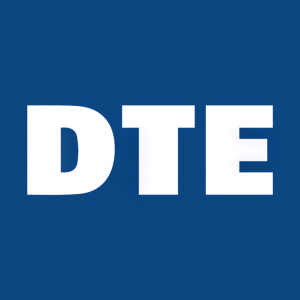Customer demand for DTE Energy’s MIGreenPower voluntary renewable program drives more solar energy projects in Michigan
DTE Energy's MIGreenPower program now has over 50,000 residential subscribers, matching Ypsilanti's population. The program adds thousands of megawatts of clean energy, driven by substantial demand from both residential and corporate customers. In 2021, DTE increased its renewable energy capacity by 40% through this initiative. Customers have enrolled 1.9 million megawatt hours of clean energy, avoiding 1.5 million tons of CO2 emissions. DTE plans additional solar projects, including a 20-megawatt array in Washtenaw County, to meet ongoing demand.
- MIGreenPower surpasses 50,000 residential subscribers.
- Clean energy projects will add thousands of megawatts to the grid.
- DTE increased renewable energy capacity by 40% in 2021 due to MIGreenPower.
- 1.9 million megawatt hours of clean energy enrolled, avoiding 1.5 million tons of CO2 emissions.
- None.
- Residential customer enrollment hits the 50,000 mark, about equal to the population of Ypsilanti
- DTE to add thousands of megawatts from new solar projects to meet customer enthusiasm
- MIGreenPower is one of country’s largest voluntary renewable energy programs
- Program demonstrates success of Michigan’s renewable energy legislation
DTE Energy’s MIGreenPower program, one of the largest voluntary renewable energy programs in the country, this week surpassed 50,000 residential subscribers - a customer base roughly equal to the population of Ypsilanti. With approximately 500 new residential customers joining each week and strong demand from some of the state’s largest corporations and non-profit organizations, the program is driving the addition of thousands of megawatts of new clean energy to the grid. “Our customers are demanding a Grid of the Future, a modern new grid delivering clean and reliable energy, and we’re delivering it,” said Jerry Norcia, president and CEO, DTE Energy.
MIGreenPower enables customers to reduce their carbon footprint by attributing more of their electricity use to local wind and solar projects beyond the
DTE’s MIGreenPower clean energy projects are being developed in addition to the projects DTE has added to meet the state’s Renewable Energy Portfolio Standard (RPS). In 2021, DTE achieved the state’s
To meet continued customer demand, DTE plans to add several new MIGreenPower solar projects ranging from a 20-megawatt array in Washtenaw County to projects exceeding 100 megawatts in rural communities in Michigan – enough to power an additional 120,000 homes. The company is issuing a Request for Proposal for 500 megawatts of new MIGreenPower wind and/or solar projects to come online in 2023. The company also has other new solar projects in various stages of development that are scheduled to come online by 2025.
In its February 2022 Report on the Implementation and Cost-Effectiveness of the P.A. 295 Renewable Energy Standard, the Michigan Public Service Commission credits voluntary renewable energy programs like MIGreenPower with becoming “a major driver of new renewable energy growth in Michigan.” The report also cites an increase in the number of customers taking advantage of their utilities’ voluntary programs to purchase more clean energy.
More about MIGreenPower and its subscribers
One of the largest voluntary renewable energy programs in the country, MIGreenPower now has more than 50,000 residential subscribers living throughout southeast Michigan, with the largest subscriber bases in Oakland, Wayne, Washtenaw and Macomb counties.
The program is also very popular with business and industrial customers, including Ford Motor Company and General Motors, as well as large automotive suppliers, who are using the program to green their operations and help meet sustainability targets. The University of Michigan, Washtenaw Community College and the Detroit Zoo also subscribe to MIGreenPower. Similarly, municipalities including the City of Ann Arbor and Pittsfield Township are working with MIGreenPower to meet their communities’ carbon reduction goals.
MIGreenPower provides DTE’s electric customers with an easy and affordable way to reduce their home’s electricity-based carbon footprint for far less than it costs to install a private generation system. Private rooftop solar systems, for example, can cost upwards of
“We want to thank all our MIGreenPower customers for their participation in this program and for helping to create a cleaner, greener Michigan,” said Trevor Lauer, president and chief operating officer of DTE’s electric company. “At DTE, we are committed to getting as clean as we can as fast as we can. Adding large-scale clean energy projects allows us to bring more clean energy to the grid to more people. It’s also less expensive, and more equitable and impactful in terms of carbon emissions avoidance.”
DTE is Michigan’s leading producer of and investor in renewable energy. The company’s 50-plus wind parks and solar farms generate enough clean energy to power nearly 700,000 Michigan homes. By 2025, the company will generate enough clean energy to power more than one million homes.
About DTE Energy
DTE Energy (NYSE: DTE) is a Detroit-based diversified energy company involved in the development and management of energy-related businesses and services nationwide. Its operating units include an electric company serving 2.2 million customers in Southeast Michigan and a natural gas company serving 1.3 million customers in Michigan. The DTE portfolio includes energy businesses focused on power and industrial projects, renewable natural gas, and energy marketing and trading. As an environmental leader, DTE utility operations will reduce carbon dioxide and methane emissions by more than
*Avoided emissions and equivalencies are based on the Environmental Protection Agency equivalencies calculator at epa.gov/energy/greenhouse-gas-equivalencies-calculator.
###
Attachment

FAQ
What is the significance of DTE Energy's MIGreenPower program for residential customers?
How much clean energy has been enrolled in the MIGreenPower program as of March 2022?
What are DTE's future plans for the MIGreenPower program?
How does MIGreenPower impact carbon emissions?







